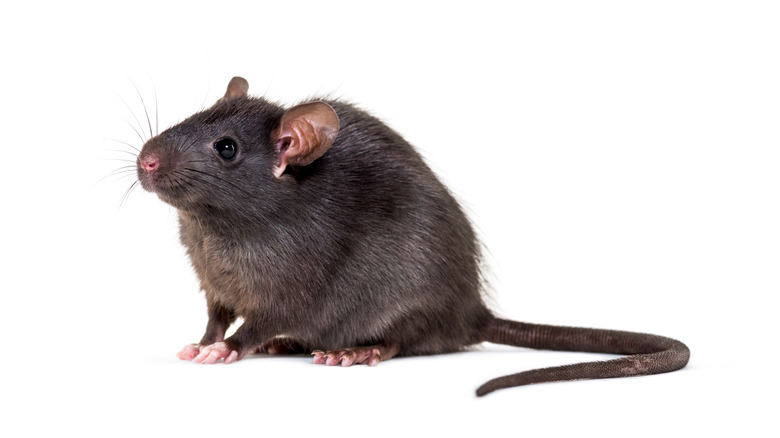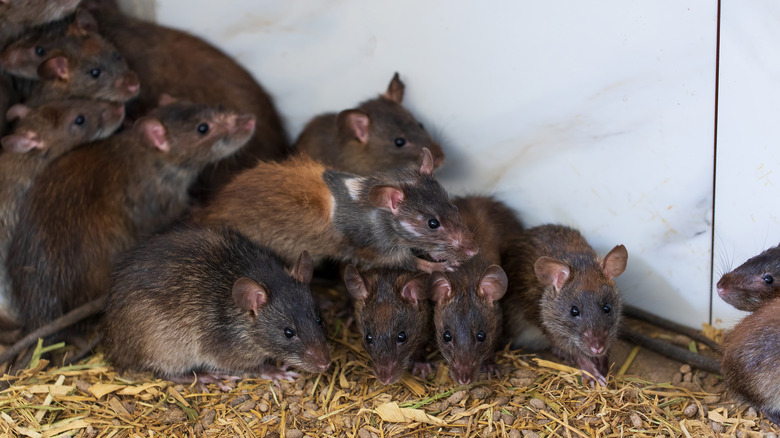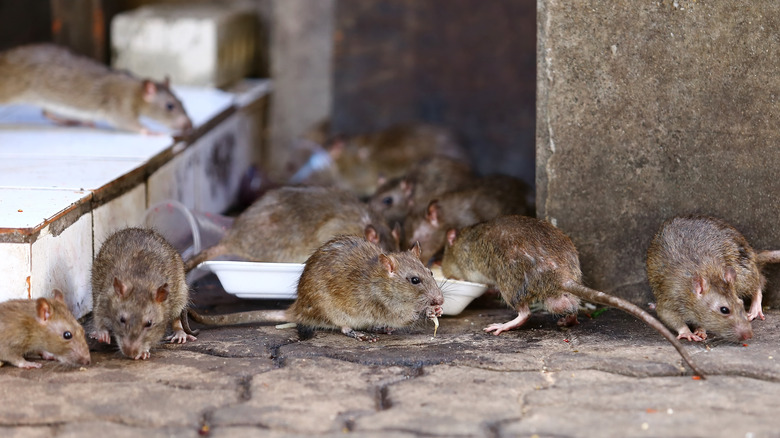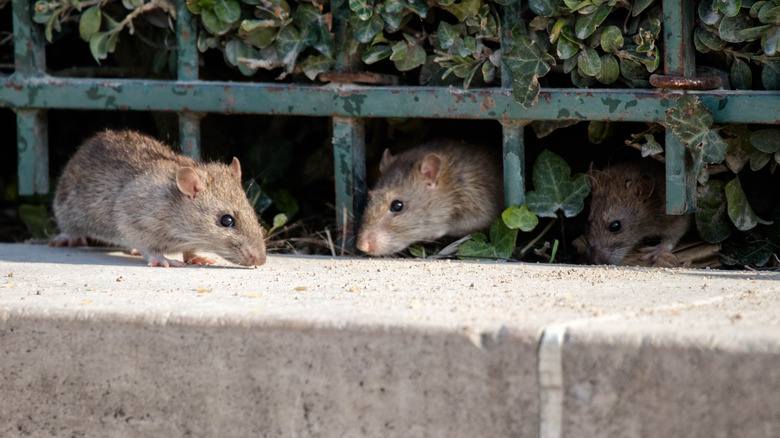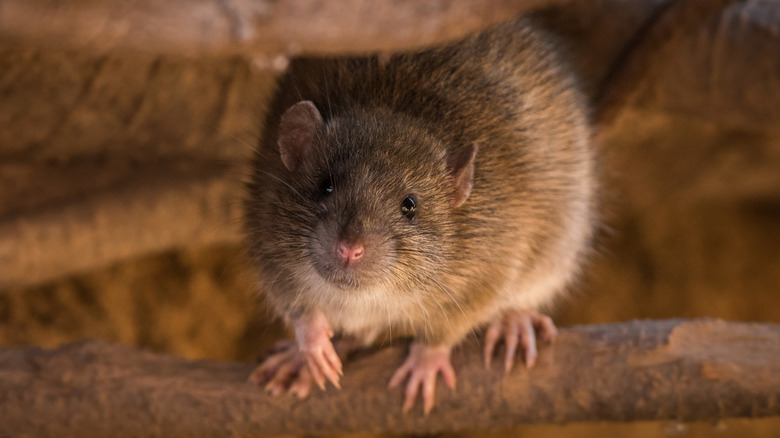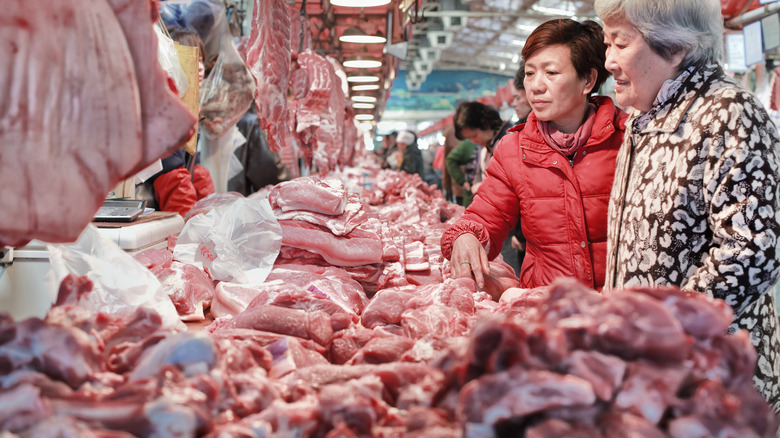The Truth About Rat Meat
In today's food world, sometimes it seems as if anything goes. Exotic meats like quail, elk, and bison are available at restaurants ranging from high-end steakhouses to gourmet hot dog stands (via Cheapism), and there's a restaurant in the U.K. that offers zebra meat, as well as the somewhat more mainstream ostrich, kangaroo, and wild boar (via Food and Wine). You can even sample edible insects at the state fair or follow in the footsteps of Andrew Zimmern and visit local eateries to sample such delights as muskrat, fermented shark meat, and jellied moose nose.
Even if you're a Zimmern-wannabe adventure eater, there is one type of meat that may give you pause — rat. There are two main reasons why most people would react with shock and horror. The first group would be upset for the same reason that we wouldn't ever want to eat dog or horse meat, because rats are often sold as pets and nobody wants to eat something so cute and clever (if admittedly not all that snuggly). Meanwhile, the second group would be revolted at the thought because they associate rats with germs and disease. Once you get past the psychological barriers, however, rats could prove to be a viable source of environmentally-friendly, sustainable meat.
Rats could transition from pests to game
Rat meat, like any other type of meat, is a valuable a source of protein. In a number of countries around the world, particularly in southeast Asia, South and Central America, and the African nation of Ghana, rodent meat is seen as a dietary staple and may be sold in supermarkets and even canned. Many of the rodents sold for culinary purposes are not wild-harvested but farmed, which is a practice that the peer-reviewed scientific journal EMBO Reports (via the National Library of Medicine) says could be beneficial if adopted by the rest of the world.
The journal spoke with Louw Hoffman, head of the meat science group at South Africa's University of Stellenbosch, who named a number of factors for why farming rats for meat makes sense. "Rats are ideal species for mini‐livestock farming as they have a high fecundity (number of babies born per year), you can have a [favorable] ratio of males to females (1:5), can be housed in small enclosures, can be group housed, and are great at converting waste food into quality protein fit for human consumption." Grant Singleton, a rodent biology expert with the International Rice Research Institute in the Philippines, agreed. "Instead of fighting rats as a pest we could welcome them as game," he stated.
Rat meat is not without risk
The long-standing association between rodents and disease is not without some merit. While rats, it turns out, don't bear much of the blame for the outbreak of bubonic plague that decimated medieval Europe (via History Channel), the CDC has an entire laundry list of diseases that can be transmitted by rodents, either directly or indirectly, including hantavirus, leptospirosis, plague, and rat bite fever. A rat-linked disease that is most likely to be transmitted by rat meat, rather than contact with live rodents is tularemia (via Mayo Clinic). According to a study published in the Journal of Wildlife Diseases (via the National Library of Medicine), the African cane rat is one species that has been found to have a high instance of salmonella, and humans can be at risk of this food-borne illness by eating improperly cooked rat meat. Whether or not rat meat tastes "just like chicken," it needs to be cooked just as carefully, or the resulting digestive upset could be equally unpleasant.
One disease that rats evidently do not carry, however, is the COVID-19 virus. While initial reports out of China (via Courthouse News Service) indicated rats were sold at the meat market where the virus first appeared, a report published by CGTN found that humans are highly unlikely to contract the virus from contact with rats, be they live or cooked.
Many consider rat meat a delicacy
According to "Unmentionable Cuisine" (via Google Books) by Calvin Schwabe, a former professor at the University California who's been dubbed "the father of veterinary epidemiology," rats made regular appearances on Parisian menus during the Franco-Prussian War. While this was due in part to the fact that the city was under siege, the reluctant rat eaters found the meat to taste pleasantly of pork and partridge. They even came up with an oh-so-French way to cook them: entrecote à la bordelaise, or grilled [rat] steak, Bordeaux-style. To make this delicacy, only wine-imbibing cellar rats would do. These self-marinating rodents were skinned, gutted, brushed with olive oil and crushed shallots before being cooked over a fire made from broken wine barrels.
In numerous parts of the world, rats may even be considered a gourmet item. In northeast India, the Adi tribe celebrates a yearly festival called Unying-Aran, which features rat meat as a centerpiece (via BBC). In Cameroon, cane rats are an expensive, yet desirable delicacy, and the same applies to the African giant rats of Nigeria. Stefan Gates, a British TV presenter, told the BBC he's eaten rat meat all over the world — and liked it. He describes the various rat-based dishes he's sampled using words such as "succulent," "juicy," "tender," and "absolutely delicious."
This vegetarian artist hosted a rat banquet at an art gallery
Laura Ginn is a vegetarian... Well, mostly. Ginn is also an artist, and much of their photography work focuses on survival skills, such as hunting, skinning, and processing animal hides. When they relocated to New York, they thought about putting those skills to use in an urban setting by utilizing the indigenous fauna. The next step was studying up on how to butcher rats and prepare them for the table. And later, the results were incorporated into a body of work Ginn exhibited in a 2012 installation at the Allegra LaViola Gallery.
The name of the installation was "Tomorrow We Will Feast Again on What We Catch." And in keeping with the name, Ginn did the sustainable thing and turned them into a banquet. According to The New York Times, 20 art world insiders (most of them friends of the gallery owner or the artist themself) dined on gourmet rat treats cooked by chef Yuri Hart, some of whom paid $100 to be there. The menu included rat leg tenderloin bruschetta and rat terrine, and Ginn attended the gala dressed in a gown made from 300 rat pelts.
How to spot rat meat
After Ginn's rat banquet, they became known as sort of an authority on cuisine de rongeur (this being the French word for a male "rodent "). In the wake of a scandal where Chinese meat suppliers had been accused of passing off rat meat as mutton, Foreign Policy reached out to Ginn to ask how to know if you're eating rat meat.
A few of their rat detection tips were obviously tongue-in-cheek, but Ginn did make the observation that raw rat meat somewhat resembles lamb (except with all those tiny little bones and a completely different shape), while cooked rat resembles rabbit. They also pointed out that rats secrete oils that give them a very distinct odor, which is said to be reminiscent of a tortilla, depending on whom you ask. According to Ginn, rat meat retains a hint of this odor as well as a rather pungent, gamey flavor no matter how it's cooked.
